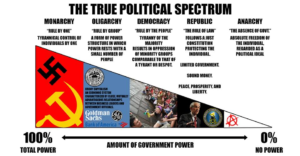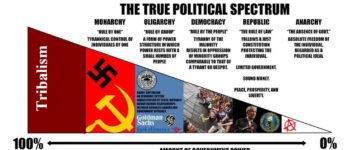1700s: Slave New Zealand
April 13, 2019
By AHNZ
 I’ve been thinking about this True Political Spectrum graph. It’s pretty good. However, I’d reserve 100% for another segment of the wedge to the left of total power: Tribalism. All powerful, all controlling.
I’ve been thinking about this True Political Spectrum graph. It’s pretty good. However, I’d reserve 100% for another segment of the wedge to the left of total power: Tribalism. All powerful, all controlling.
To live among bickering battering barbarians and then to have Alexander the Great come along and Empire-up your town would be a big relief. For you and your wife and children to be pawns for life in a never-ending back and forth between feuding locals is the greatest oppression of all. Better to have the British or Roman Empire roll into your feuding little Arcadia to bring laws and rights. So, I’ve added a little extension off to the left…
None are less free than those who live in tribal society, contra Rousseau. Even the masters must adhere to a strict hierarchical code or risk being toppled by their underlings or superiors. New Zealand tribal society was like this too, class-based. Each tribe had a controlling minority of nobles and it was they, and only they, who had access to the higher culture. No slave could be a tohunga of healing, navigation, teaching, magic, carving, politics, building.
A Maori slave’s life could be forfeit at any moment, there were no individual rights! Because a noble is hungry, or just because they’re angry and feel like lashing out with a bit of recreational homicide. Not for them, a special burial ceremony and tomb. Their remains are for the midden pit, after being eaten up. Their skins were marked against their will, with designs against their will, to brand them as the belonging to the tribe. Don’t try escaping to another tribe where conditions are better- you’re marked for recognition. Like a sheep with an ear tag. You might be stolen and re-branded by another tribe but that wasn’t up to you.
Legally speaking, this all came to a sudden stop in 1840 when all Maoris- nobles and slaves- became British citizens with all the rights and privileged thereof. However, Maoris had been making that transition through Christianity themselves without it being enforced from above by a Governor.
Hey kids. Know what I inherited as a Maori?…My family were slaves..My branch of the Heke line was descended from a slave. A fulla taken prisoner by the enemy when he shoulda- he woulda- been better off dyin.- Once Were Warriors, Alan Duff (1990)
This was a massive cultural change to try to deal with that is little discussed. Recognising there is a challenge and crisis here at all gets in way of the r-selected anti-individuality myth that all the Maoris in a given tribe were like happy egalitarian Smurfs in Smurf Village. Singing kumbaya, hugging trees, refraining from using non-renewable like plastic, and conserving forests and animals. The myth even extends to the conceit that there was one Maori people with one calendar and one language; Rubbish.
How much do the ethonology and memes of the past ripple into today? How to attitudes and susceptibilities impact on health and education and political outcomes for Once Were Tribal people living in New Zealand today? Who is being exploited? Who makes money from re-enforcing these old archetypes? Does anyone champion today the unfinished project of ending slavery for all New Zealanders, not just Maoris? Such questions are Politically Incorrect.
Tribalism didn’t even make it onto the original chart. Anarchism is confused with primitive tribal feuding and poverty when, in fact, they are at opposite ends of the spectrum and of historical development.
—
Note: Slave New Zealand is older and newer than the 1700s; This date is arbitrary
Image ref. Being Libertarian
 Like Comment Share
Like Comment Share






